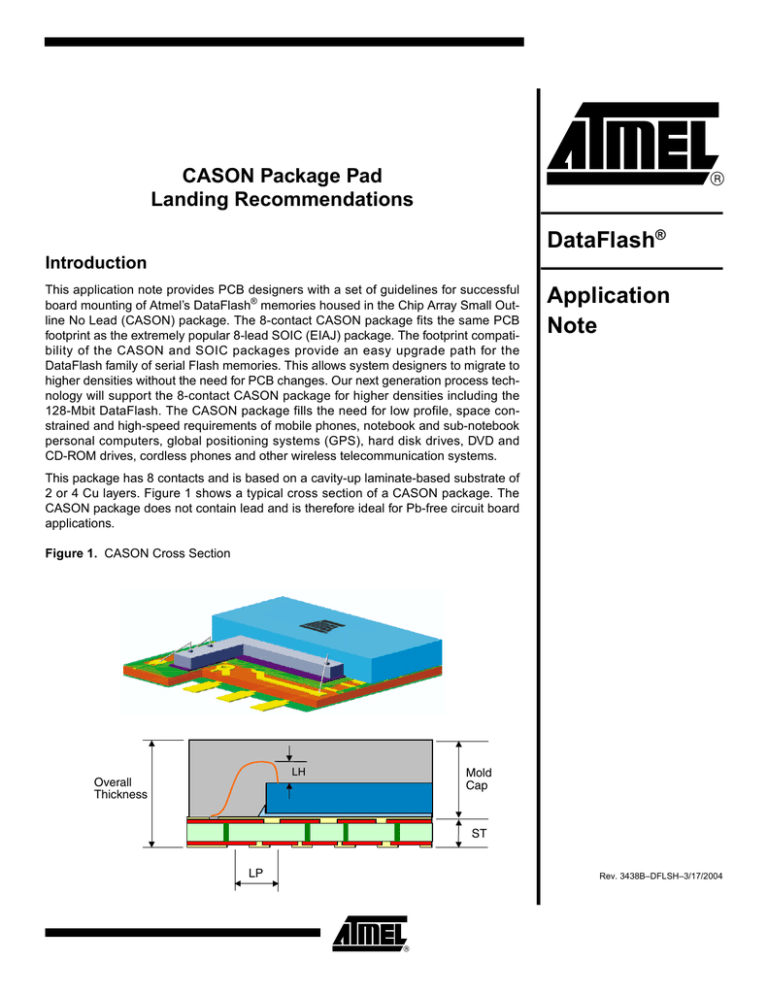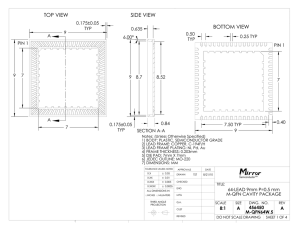
CASON Package Pad
Landing Recommendations
DataFlash®
Introduction
This application note provides PCB designers with a set of guidelines for successful
board mounting of Atmel’s DataFlash® memories housed in the Chip Array Small Outline No Lead (CASON) package. The 8-contact CASON package fits the same PCB
footprint as the extremely popular 8-lead SOIC (EIAJ) package. The footprint compatibility of the CASON and SOIC packages provide an easy upgrade path for the
DataFlash family of serial Flash memories. This allows system designers to migrate to
higher densities without the need for PCB changes. Our next generation process technology will support the 8-contact CASON package for higher densities including the
128-Mbit DataFlash. The CASON package fills the need for low profile, space constrained and high-speed requirements of mobile phones, notebook and sub-notebook
personal computers, global positioning systems (GPS), hard disk drives, DVD and
CD-ROM drives, cordless phones and other wireless telecommunication systems.
Application
Note
This package has 8 contacts and is based on a cavity-up laminate-based substrate of
2 or 4 Cu layers. Figure 1 shows a typical cross section of a CASON package. The
CASON package does not contain lead and is therefore ideal for Pb-free circuit board
applications.
Figure 1. CASON Cross Section
LH
Overall
Thickness
Mold
Cap
ST
LP
Rev. 3438B–DFLSH–3/17/2004
PC Board Design
Guidelines
The IPC-SM-782 is an industry-standard specification for determining PCB land patterns. The standard provides the guidelines by which the PC Board (PCB) pattern
should be designed. However, working with an Electronics Manufacturing Service provider and/or PCB design house with experience in designing and mounting this package
type is recommended. The following guidelines are offered based on best known practice, research and evaluations by packaging design manufacturers.
PCB Land Pattern and
Solder Mask Design
The CASON package is primarily composed of copper on a BT resin core. This adds
stiffness to the package and uniform expansion during board mount and board level
temperature cycling. A typical package outline and appropriate tolerances are shown in
Figure 2. The solder lands on the package side are Non Solder Mask Defined (NSMD);
i.e. the pad is slightly smaller than the opening in the Solder Mask. The land pattern on
the PCB should be designed to correspond with the land pattern on the package. The
land on the PCB should be Non Solder Mask Defined (NSMD) in order to realize the
best board level reliability performance. The X & Y values of the solder land pad on the
PCB should be equal to, or no more than 20% smaller than that of the package solder
land. Refer to Figure 3 for the X and Y dimensions.
Designing the PCB land (X,Y) dimensions equal to the solder land of the package is
quite common, however, making the NSMD land pad on the board a little smaller can
increase the stand-off and board level reliability.
When the PCB lands are the exact same size as the package lands, board level temperature cycling will eventually cause a solder joint failure at the solder joint to package
land interface. By slightly decreasing the PCB pad land, the failure point will not shift to
the PCB to solder joint interface, and the number of temperature cycles achieved may
see a positive impact.
The board traces leading into the CASON land pads (on the PCB) should not be wider
than the minimum dimension of the land pad either X or Y. This is to avoid excessive
solder paste wicking along the trace, away from the joint area and possibly impacting
board level reliability.
Figure 2. Package Outline Drawing
0.97 mm (TYP)
Pin 1 Pad Corner
0.10 mm (TYP)
1
8
1
1
7
2
6
3
5
4
1.27 mm
Ma rked Pin 1 Identifier
6.0 mm
(TYP)
1.095 mm (REF)
0.41 mm (TYP)
0.67 mm (TYP)
8.0 mm (TYP)
Bottom Vie w
Top View
1.0 mm
(MAX)
Side V iew
2
0.21 mm (TYP)
CASON Package Pad Landing Recommendations
3438B–DFLSH–3/17/2004
CASON Package Pad Landing Recommendations
Figure 3. PCB Land Pattern Design Guidelines (Rectangular NSMD)
Ypkg
Ypcb
Xpcb
Xpkg
Land Pitch
(P) (mm)
Land Pad
Length (X)
Typ (mm)
Land Pad
Width (Y)
Typ (mm)
1.27
0.67
0.41
Note:
PCB Pad Length (X) (mm)
PCB Pad Width (Y) (mm)
Min
Max
Min
Max
0.54
0.67
0.33
0.41
While rectangular pads are typically 50% of the pitch in width; it is not a rigid rule. Therefore, other formats are possible. Nonetheless, the PCB pad should be 80% to 100% of
the package solder land in X & Y.
Board Assembly
Guidelines
Most reputable Electronics Manufacturing Service providers have their own rules, guidelines, and standard practice regarding mounting surface mount packages in general.
However, the following guidelines and principles have been characterized and proven to
result in a reliable board assembly.
Stencil Design
•
Laser cut stencil with electropolished walls is recommended.
•
For NSMD pads aperture size to PCB pad size is typically 1:1 ratio with 0.125 to
0.150 mm thick stencil.
•
Water soluble or No-Clean paste can be used (Type 3).
Paste and Reflow
•
–
37%Pb-63%Sn eutectic paste
–
Sn-3%Ag-0.5%Cu lead free paste
The reflow profile depends on the thermal mass of the other packages on the board.
The CASON package will most likely be one of the lower mass packages on the
board. Studies have shown good results when using the following reflow guidelines
based on the solder paste used:
–
For PbSn Paste: The reflow peak temperature should be kept in the 215°C
to 225°C range. An actual reflow profile used to produce good board level
reliability result is shown in Figure 4 (no clean paste).
–
For PbFree Paste: The reflow peak temperature should be kept in the
225°C to 245°C range. An actual reflow profile used to produce good board
level reliability result is shown in Figure 5 (no clean paste).
Note:
•
For more detailed reflow information, refer to JEDEC-STD-020.
No Clean pastes typically have shorter reflow profiles and dwells as the alcohol
based solvent activates rapidly. Follow the paste manufacturers recommended
profile and application notes. Also, no clean pastes have flux that is typically less
active so reflow in Nitrogen environment (<75 ppm) may be advised.
3
3438B–DFLSH–3/17/2004
Figure 4. PbSn Reflow Profile
Note:
Time between 150°C - 170°C: 120 sec
Time above 183°C: 50 sec
Peak Temp: 218°C
Figure 5. Pb-Free Reflow Profile
Note:
4
Time between 130°C - 160°C: 120 sec
Time above 217°C: 60 - 70 sec
Peak Temp: 235.5°C
CASON Package Pad Landing Recommendations
3438B–DFLSH–3/17/2004
CASON Package Pad Landing Recommendations
Rework
Footprint
Compatibility
The CASON package is relatively easy to rework due to low thermal mass and high temperature stability.
•
Bake board at 125°C at least 2 hours prior to part removal.
•
Make sure board is flat to avoid tilting and improper removal that could cause
bridging of solder.
•
Under board heat is not normally required, if desired, maintain 120°C.
•
Make sure hot gas nozzles are properly directed at part to be removed.
–
PbSn: Peak temperature should be 200°C.
–
PbFree: Do not exceed peak temperature of 225°C, if possible.
•
Lift off part with integrated vacuum pick-up and clean the site properly with solder
wick or alternative method.
•
On rework printer/placer take care to properly align and print the same solder paste
with a metal blade and a miniature stencil.
•
Properly place the new package within 0.15 mm accuracy, if possible, and use the
same reflow profile as used to initial mount package.
The 8-contact CASON package (8CN3) is footprint compatible to the EIAJ standard 8lead SOIC (8S2). This 8-pin footprint allows easy density migration without board
changes. Future die shrinks will enable densities up through 128 Mbits to fit into this
footprint. Consult the current DataFlash datasheets for availability. Figure 6 demonstrates CASON and SOIC compatibility.
Figure 6. CASON and SOIC Compatibility
5
3438B–DFLSH–3/17/2004
Atmel Corporation
2325 Orchard Parkway
San Jose, CA 95131, USA
Tel: 1(408) 441-0311
Fax: 1(408) 487-2600
Regional Headquarters
Europe
Atmel Sarl
Route des Arsenaux 41
Case Postale 80
CH-1705 Fribourg
Switzerland
Tel: (41) 26-426-5555
Fax: (41) 26-426-5500
Asia
Room 1219
Chinachem Golden Plaza
77 Mody Road Tsimshatsui
East Kowloon
Hong Kong
Tel: (852) 2721-9778
Fax: (852) 2722-1369
Japan
9F, Tonetsu Shinkawa Bldg.
1-24-8 Shinkawa
Chuo-ku, Tokyo 104-0033
Japan
Tel: (81) 3-3523-3551
Fax: (81) 3-3523-7581
Atmel Operations
Memory
2325 Orchard Parkway
San Jose, CA 95131, USA
Tel: 1(408) 441-0311
Fax: 1(408) 436-4314
RF/Automotive
Theresienstrasse 2
Postfach 3535
74025 Heilbronn, Germany
Tel: (49) 71-31-67-0
Fax: (49) 71-31-67-2340
Microcontrollers
2325 Orchard Parkway
San Jose, CA 95131, USA
Tel: 1(408) 441-0311
Fax: 1(408) 436-4314
La Chantrerie
BP 70602
44306 Nantes Cedex 3, France
Tel: (33) 2-40-18-18-18
Fax: (33) 2-40-18-19-60
ASIC/ASSP/Smart Cards
1150 East Cheyenne Mtn. Blvd.
Colorado Springs, CO 80906, USA
Tel: 1(719) 576-3300
Fax: 1(719) 540-1759
Biometrics/Imaging/Hi-Rel MPU/
High Speed Converters/RF Datacom
Avenue de Rochepleine
BP 123
38521 Saint-Egreve Cedex, France
Tel: (33) 4-76-58-30-00
Fax: (33) 4-76-58-34-80
Zone Industrielle
13106 Rousset Cedex, France
Tel: (33) 4-42-53-60-00
Fax: (33) 4-42-53-60-01
1150 East Cheyenne Mtn. Blvd.
Colorado Springs, CO 80906, USA
Tel: 1(719) 576-3300
Fax: 1(719) 540-1759
Scottish Enterprise Technology Park
Maxwell Building
East Kilbride G75 0QR, Scotland
Tel: (44) 1355-803-000
Fax: (44) 1355-242-743
Literature Requests
www.atmel.com/literature
Disclaimer: Atmel Corporation makes no warranty for the use of its products, other than those expressly contained in the Company’s standard
warranty which is detailed in Atmel’s Terms and Conditions located on the Company’s web site. The Company assumes no responsibility for any
errors which may appear in this document, reserves the right to change devices or specifications detailed herein at any time without notice, and
does not make any commitment to update the information contained herein. No licenses to patents or other intellectual property of Atmel are
granted by the Company in connection with the sale of Atmel products, expressly or by implication. Atmel’s products are not authorized for use
as critical components in life support devices or systems.
© Atmel Corporation 2004. All rights reserved. Atmel ® and combinations thereof and DataFlash ® are the registered trademarks of Atmel Corporation or its subsidiaries. Other terms and product names may be the trademarks of others.
Printed on recycled paper.
3438B–DFLSH–3/17/2004




